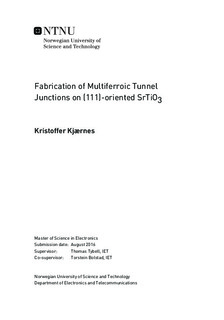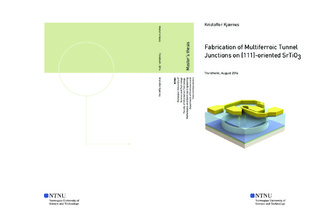| dc.description.abstract | The phenomenon of quantum mechanical electron tunneling is widely used in device technology, of which magnetic tunnel junctions (MTJ) have been important for many years and ferroelectric tunnel junctions (FTJ) are becoming increasingly important. MTJs consist of two ferromagnetic electrodes separated by a thin insulating barrier material while FTJs have a thin ferroelectric insulator separating two metallic electrodes. The probability for tunneling through these junctions depend on the relative orientation of the magnetic electrodes in MTJs, or the direction of polarization relative to the tunneling electrons in FTJs. Two stable states are usually obtained in each type of junction, which gives rise to different electrical resistance for the two states. These effects are known as the tunnel magnetoresistance (TMR) in MTJs and tunnel electroresistance (TER) in FTJs.
MTJs and FTJs are subject to large research efforts, particularly for use in memory applications. Furthermore, the two concepts may be joined in the same device with ferromagnetic electrodes separated by a thin ferroelectric barrier. These junctions are sometimes referred to as artificial multiferroic tunnel junctions (MFTJ), because they represent a device which has multiple ferroic orders, but where none of the constituent materials are more than singly ferroic. An increasing amount of research is devoted to MFTJs, as they are promising for memory applications where the two degrees of freedom can utilize both TMR and TER at the same time in the same memory cell. Effectively, this can give four distinct electrical resistance states, which can be used to hold two bits of information. Moreover, a third possibility opens by considering non-nollinear magnetic alignments of the magnetic electrodes, which may give rise to additional resistance states and another information bit. Consequently, a substantial increase of memory density can be achieved if the memory cell size is kept equal to former technologies.
Here, two model systems for MFTJs on (111)-oriented SrTiO3 (STO) substrates are designed and fabricated for the study of ferroelectric and ferromagnetic coexistence. Epitaxial structures of ferromagnetic, half-metallic La0.7Sr0.3MnO3 (LSMO) followed by ferroelectric BaTiO3 (BTO), grown on (111)-oriented STO substrates, are utilized as bottom electrode and insulating barrier materials, respectively. Sputter deposited Ni0.81Fe0.19 (permalloy) and epitaxial LSMO with a sputtered Pt capping and contacting layer, are used as ferromagnetic top electrodes for asymmetric permalloy MFTJs and all-oxide epitaxial MFTJs, respectively. The fabrication is done by electron beam lithography (EBL) and overlay exposure to define precise micron scale MFTJs.
Room temperature wedge-wedge bonding with gold and aluminium wire to either Au or Al bond pads are reported with highly reproducible results.
Evidence for TMR with multiple resistance states between the totally parallel and antiparallel magnetic alignments as well as TER with resistive switching are presented. The TMR results indicate intermediate magnetic alignments which are stable and switchable without using multiple directions of the applied magnetic field. Furthermore, the TER results imply the presence of simultaneous ferroelectric switching.
Investigations on scripting the Quantum Design VersaLab Electrical Transport Option (ETO) with Visual Basic programming is performed in order to do more specific electrical characterization of the fabricated MFTJs. Promising low-current measurements of differential resistance and capacitance versus DC-current are reported, by utilizing AC lock-in data from measurements directly. | |

